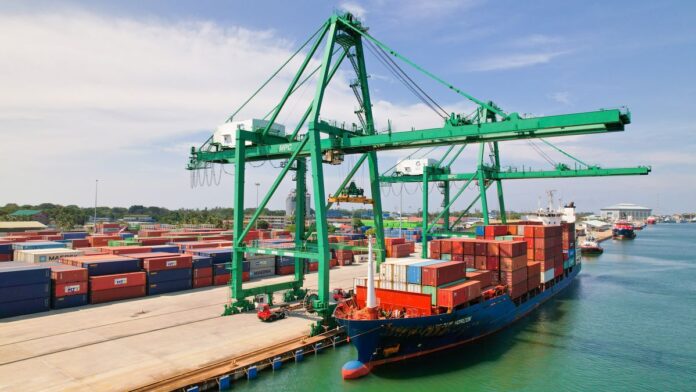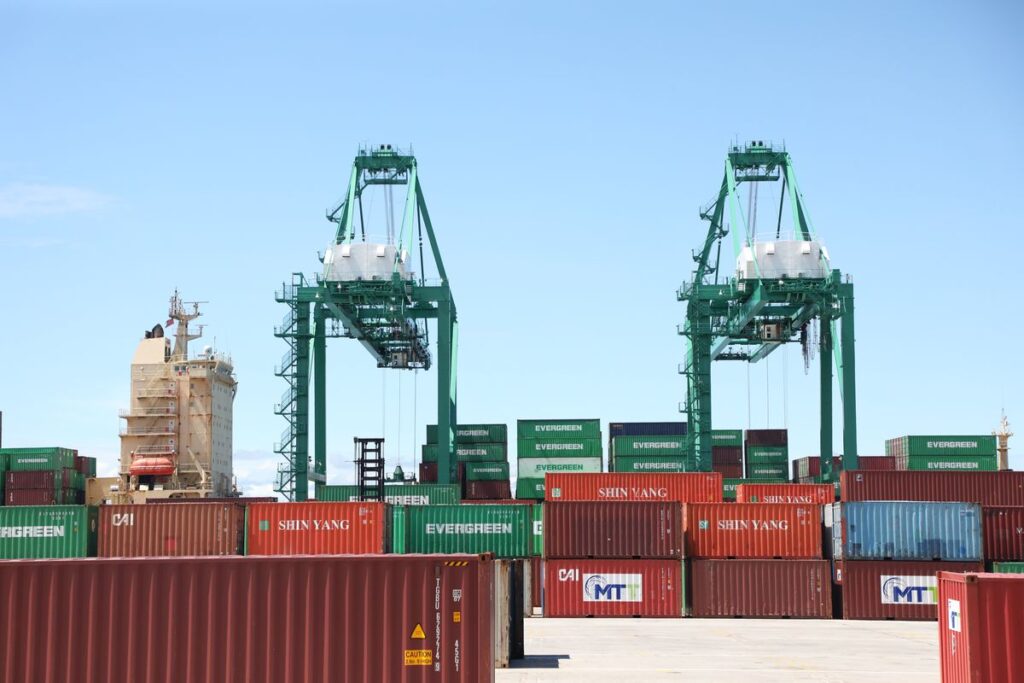
Muara Port Company (MPC) oversees the management of Brunei’s main port and is responsible for bolstering economic ties and fostering collaborations among the countries of Brunei Darussalam, Indonesia, Malaysia, and the Philippines (BIMP-EAGA).
MPC has embarked on ambitious port expansion plans scheduled for completion by 2027.
The expansion includes the site growing to over 16 hectares and the construction of a new 250-meter container terminal, doubling the port’s current capacity of 220,000 TEUs to 500,000 TEUs a year.
The berthing area will also be deepened to 13 meters to accommodate container vessels up to 30,000 DWT, with a designated free trade zone (FTZ) of 3.6 hectares within the new site where importing, producing, repackaging, and exporting can be done with ease.
To enhance operational efficiency and capacity, MPC has already deployed advanced technologies such as Terminal Operating Systems (TOPS) and Electronic Data Interchange (EDI) systems. These upgrades are vital for attracting clients and meeting the evolving needs of the maritime sector.
Furthermore, new opportunities for growth and investment are emerging, with Brunei’s exports to the UAE on the rise. Muara Port’s strategic position provides a convenient gateway for shipping liners to explore new trade routes and expand their operations.
We sit down with MPC’s COO Fazilah Yassin to delve deeper into Muara Port’s transformation.

Q&A: Muara Port Company Chief Operating Officer

Can you outline the strategic vision you have set out for MPC under your leadership, and what milestones have you reached so far?
In overseeing the operation and management of Muara Port, our strategic vision revolves around expanding the shipping line and leveraging the potential of the BIMP-EAGA region. This includes devising a comprehensive plan for the forthcoming port expansion. We have also outlined plans to construct an additional nearby port. These initiatives currently define our strategic direction.
Recognizing the shipping line’s vital role in regional trade, we have taken extensive steps to enhance and optimize our shipping services. This includes collaborating closely with key companies to explore route expansion and increased vessel frequency to Muara Port. Our goal is to adapt to the evolving needs of the shipping industry and position ourselves as a central hub and efficient gateway, particularly in the BIMP-EAGA region.
Last year, we inaugurated a maiden container shipping route to China, connecting Muara Port to Qinzhou in Guangxi, southern China, significantly reducing travel time to seven days. Operated by Harbor Link Group, our partner in this endeavor, this route has enhanced connectivity between Brunei and China, facilitating streamlined cargo transport and opening avenues for seamless connectivity to China’s new Land-Sea Corridor.
As a fundamental aspect of our strategic approach, we actively embrace the objectives of the BIMP-EAGA initiatives, focusing on bolstering economic ties and fostering collaborations among Brunei, Indonesia, Malaysia, and the Philippines. Strategically positioned within the region, Muara Port aims to actively contribute to its economic development, promoting trade and cooperation among these nations.
Our port expansion plan aims to support the expected increase in shipping line and trade volumes from the BIMP-EAGA region. It includes assessing and enhancing current infrastructure, constructing a new 250-meter container terminal, and expanding the land area to over 16 hectares. Procurement will involve acquiring quay cranes, rail-mounted gantry cranes, and a high-tech terminal operating system. Deepening the berthing area will accommodate container vessels up to 30,000 DWT, with a designated free trade zone to streamline operations.
Our strategic vision for Muara Port revolves around expanding the shipping line, aligning with BIMP-EAGA initiatives, and planning for future port expansion. By addressing the specific needs of the shipping industry and fostering regional collaboration, Muara Port is positioned to play a pivotal role in the dynamic landscape of maritime trade in the upcoming years.
How will your strategic direction transform this port into a regional hub?
Our vision is to become a regional hub driving Brunei’s logistics and manufacturing growth. Implementing a multifaceted strategy, we invest in state-of-the-art infrastructure at Muara Port to enhance efficiency and capacity, crucial for attracting clients and meeting evolving sector needs, including accommodating foreign direct investment requirements.
Modernizing our facilities provides a competitive platform for Brunei’s businesses and the region. Efficient IT platforms and digitalization ensure seamless operations, aligned with the Wawasan Brunei 2035 national vision for economic diversification and sustainable development. Collaboration with government bodies, shipping companies, and industry players creates a supportive logistical ecosystem.
Strategic planning considers governmental needs, regulations, and future projections to meet tonnages and container volumes for the next decade. Partnering with shipping lines ensures a seamless flow of goods, contributing to Brunei’s long-term economic objectives. Our dedication lies in advancing economic growth and positioning Muara Port as a key player in regional trade.
As Brunei stands as Southeast Asia’s third-largest oil and petrochemical exporter, how are you contributing to the operational advancement of infrastructure crucial to sustaining this growth?
Though our geographical position limits direct involvement in Brunei’s lucrative oil and gas industry, our commitment goes beyond mere participation. Muara Port serves as a vital hub for vessels engaged in oil and gas activities, providing essential services such as crew changes and equipment handling.
Our support extends to facilitating bunkering services and other crucial functions for supply vessels in the sector. Additionally, our role in exporting urea, a downstream product of oil and gas, significantly contributes to Brunei’s economy as MPC facilitated the export of nearly 600,000 tons of urea in 2023.
While not directly engaged in oil and gas shipments, our logistical support plays a pivotal role in its operations and Brunei’s economic growth. This collaboration highlights the interdependence between the sector and Muara Port’s infrastructure.

With Brunei’s exports to the UAE reaching $25.2 million in 2021 alone, how does Muara Port plan to facilitate and capitalize on this growth, and what investment prospects does it offer for UAE stakeholders?
The shared cultural and religious values between Brunei and the UAE, both Muslim countries, offer a significant advantage for trade. Brunei’s widely recognized Halal certification streamlines trade processes and fosters mutual trust, particularly beneficial for businesses in both nations. Muara Port’s strategic position can serve as a gateway for shipping liners, including those from the UAE, to explore new trade routes and expand their operations.
Encouraging collaboration between Brunei and UAE-based shipping companies can lead to innovation in logistics and the creation of efficient supply chains. Leveraging Muara Port’s strategic position presents a compelling opportunity to establish it as a dynamic free trade hub. Focusing on attracting investments in the Halal food industry near the port can appeal to UAE investors seeking opportunities in Brunei’s renowned Halal-certified products.
Brunei’s Halal food industry, compliant with Islamic dietary laws, presents a promising avenue for expansion into the UAE market, known globally for Halal trade and consumption. Muara Port can serve as the entry point for Brunei’s Halal food exports into the UAE, capitalizing on the reputation of both countries for high-quality, ethically sourced products.
Emphasizing sustainable practices and responsible sourcing further enhances Brunei’s appeal as a preferred partner for UAE businesses, aligning with global sustainability goals. Overall, Muara Port’s strategic location, coupled with its alignment with Halal certification standards and potential collaboration with UAE investors and shipping partners, positions it as a key catalyst for driving trade growth between Brunei and the UAE.
With the direct route to China reducing shipping time from a month to seven days, how does this achievement correspond with your strategic objectives of expanding trade partnerships?
The new container shipping link with China plays a crucial role in strengthening trade connectivity for Brunei. It offers more efficient and direct trade routes, positioning Muara Port as a vital gateway for Brunei’s exports, particularly seafood and fresh produce. By reducing transport times and costs, this initiative enhances accessibility and makes Muara Port a preferred trade partner for businesses in both countries.
The connection to Qinzhou presents opportunities for Brunei within the broader context of the Belt and Road Initiative, aligning with our commitment to regional economic development and global trade corridors. By integrating into these networks, Muara Port enhances its role as a key player in facilitating international trade and cooperation.
In summary, the launch of the container shipping link to China underscores Muara Port’s dedication to expanding its trade network. It solidifies Muara Port’s position as a dynamic and strategically located hub, fostering collaborations with key partners and contributing to Brunei’s economic prosperity on a global scale.
Could you elaborate on the recent investments in state-of-the-art cranes and infrastructure, and how they are enhancing operational efficiency at the port?
In response to Brunei’s global economic positioning and the imperative for efficiency, Muara Port has strategically implemented digitalization initiatives to enhance operational efficiency. These initiatives include the deployment of technologies such as Terminal Operating Systems (TOPS) and Electronic Data Interchange (EDI) systems.
TOPS, known as TOPS 5, was implemented a year after MPC’s establishment, demonstrating our commitment to remaining at the forefront of technological advancements in the maritime industry. This robust system facilitates seamless communication between various operational aspects, providing comprehensive real-time data to enhance decision-making processes. By leveraging TOPS 5, MPC aims to optimize port performance, creating an efficient and responsive container terminal environment.
The integration of EDI systems represents a transformative step in Muara Port’s digitalization journey. This technological upgrade is not only strategic but also a comprehensive initiative aimed at easing communication and data exchange with shipping companies and other stakeholders. The adoption of EDI has a ripple effect on establishing a more transparent and responsive supply chain ecosystem, aligning Muara Port with the evolving demands of modern maritime logistics.
How are you integrating green and sustainable initiatives into your business operations?
Muara Port is committed to advancing sustainable port management practices by collaborating with relevant authorities, environmental organizations, and industry experts to stay abreast of the latest trends and best practices. Several initiatives have been incorporated into our port expansion plan to support this commitment.
One key initiative involves transitioning our terminal equipment, including quay cranes and rail-mounted gantry cranes, to electric power. While some ports still rely on engines or diesel for such equipment, our new terminal will operate entirely on electricity. This decision aligns with our goal to support green initiatives and minimize environmental impact.
Additionally, we are implementing simple yet effective measures such as the use of LED lights to illuminate the terminal and office spaces. This initiative underscores our commitment to sustainability across all aspects of port operations.
With your extensive experience and demonstrated ability to streamline operations and add value, how have past experiences contributed to your growth and management acumen in your current role?
My leadership approach is deeply influenced by my nearly eighteen years’ experience in navigating port challenges and operations. Three key aspects shape my leadership style.
Firstly, streamlining operations is my top priority, drawing from my experience across various port capacities. I focus on efficient cargo handling, minimizing bottlenecks, and optimizing resource allocation for swift movement. This involves implementing standard operating procedures (SOPs) across port operations and prioritizing best practices and safety. I also strategically arrange containers in the yard based on destination and vessel loading sequence.
Secondly, I prioritize infrastructure development. Continuous improvement is essential to meet growing cargo volumes and industry demands. I advocate for strategic investments, like expanding berth facilities and upgrading cargo handling equipment, to enhance capacity, efficiency, competitiveness, and global presence. For example, our efforts supporting the BFI project involved reorganizing our terminal and improving infrastructure for smoother operations and national benefit.
Finally, setting ambitious targets drives our performance. We aim to increase cargo, reflecting our confidence in achieving this goal through diligent efforts and collaboration.
With the upcoming addition of the second extended terminal, what will be the expanded capacity of your port facilities?
The new extended terminal will double our capacity, emphasizing the importance of technology integration. Technological advancements are reshaping port operations, offering opportunities for efficiency and productivity improvements.
Implementing a state-of-the-art terminal operating system with real-time monitoring for cargo movement and equipment is key. This provides instant performance evaluation, maintaining high standards. Positive feedback in 2019 showcased our improvement, motivating us to sustain momentum and meet high client expectations amid our expansion plans.
My leadership at Muara Port prioritizes efficiency, infrastructure development, and technology integration, aiming to lead the industry and adapt to evolving global trade demands. Versatility and agility are crucial for continued progress.
When is the expected completion date for the port expansion, and which contractors have been enlisted for the project?
Construction is scheduled to commence in the fourth quarter of this year, with an expected completion in either the first or second quarter of 2027. We aim to minimize delays throughout the project timeline. Finalization of the EPC contractor is pending, subject to board approval. Once deliberated, a decision will be made regarding the contractor.
This is an edited, extended version of the article in Gulf News’ Brunei Business Feature published on July 29, 2024.

Brunei Business Feature published in Gulf News, an initiative by BEDB











![[Video] Inside Brunei Fertilizer Industries: Pioneering Brunei’s entry into the global fertiliser market](https://www.bizbrunei.com/wp-content/uploads/2025/03/BFI-Youtube-Thumbnail-100x70.jpg)
